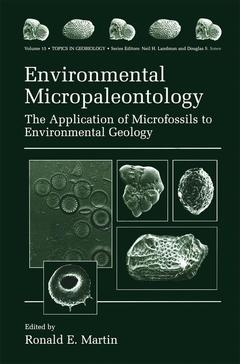Description
Environmental Micropaleontology, 2000
The Application of Microfossils to Environmental Geology
Topics in Geobiology Series, Vol. 15
Coordinator: Martin Ronald E.
Language: English
Subjects for Environmental Micropaleontology:
Keywords
Palaeontology; ecology; ecosystems; environment; pollution; hydrogeology; terrestrial pollution
Environmental Micropaleontology
Publication date: 10-2012
481 p. · 15.5x23.5 cm · Paperback
Publication date: 10-2012
481 p. · 15.5x23.5 cm · Paperback
Environmental micropaleontology
Publication date: 07-2000
500 p. · Hardback
Publication date: 07-2000
500 p. · Hardback
Description
/li>Contents
/li>
Microfossils are ideally suited to environmental studies because their short generation times allow them to respond rapidly to environmental change. This book represents an assessment of the progress made in environmental micropalaeontology and sets out future research directions. The taxa studied are mainly foraminifera, but include arcellaceans, diatoms, dinoflagellates, and ostracodes. The papers themselves range from reviews of applications of particular taxa to specific case studies.
I Baseline Studies of Foraminifera.- 1 When Does Environmental Variability Become Environmental Change? The Proxy Record of Benthic Foraminifera.- 2 Distribution Trends of Foraminiferal Assemblages in Paralic Environments: A Base for Using Foraminifera as Bioindicators.- II Water Quality in Modern Marine, Marginal Marine, and Freshwater Environments.- 3 Benthic Foraminifera as Bioindicators of Heavy Metal Pollution: A Case Study from the Goro Lagoon (Italy).- 4 Impact of Anthropogenic Environmental Change on Larger Foraminifera: Tarawa Atoll, Kiribati, South Pacific.- 5 Larger Foraminifera as Indicators of Coral-Reef Vitality.- 6 Ostracoda in Detection of Sewage Discharge on a Pacific Atoll.- 7 Ostracodes as Indicators of River Pollution in Northern Israel.- 8 Ostracoda as Indicators of Conditions and Dynamics of Water Ecosystems.- III Physiological Responses of Foraminifera to Pollution.- 9 Environmental Variation and Foraminiferal Test Abnormalities.- 10 Chemical Ecology of Foraminifera: Parameters of Health, Environmental Pathology, and Assessment of Environmental Quality.- IV Disturbance and Recovery Through Time.- 11 Use of Arcellacea (Thecamoebians) to Gauge Levels of Contamination and Remediation in Industrially Polluted Lakes.- 12 Sedimentary Diatoms and Chrysophytes as Indicators of Lakewater Quality in North America.- 13 Dinoflagellate Cysts as Indicators of Cultural Eutrophication and Industrial Pollution in Coastal Sediments.- 14 Environmental Stratigraphy: A Case Study Reconstructing Bottom Water Oxygen Conditions in Frierfjord, Norway, over the Past Five Centuries.- 15 Foraminifera of Storm-Generated Washover Fans: Implications for Determining Storm Frequency in Relation to Sediment Supply and Barrier Island Evolution, Folly Island, South Carolina.- 16 Benthic Foraminiferal Distributions in South Florida: Analogues to Historical Changes.- 17 Variation in Natural vs. Anthropogenic Eutrophication of Shelf Areas in Front of Major Rivers.- V Aquifers and Engineering.- 18 Establishing a Hydrostratigraphic Framework Using Palynology: An Example from the Savannah River Site, South Carolina.- 19 Construction of the Thames Barrier: An Application of Micropaleontology to the Solution of an Environmental Problem.
© 2024 LAVOISIER S.A.S.
These books may interest you

Aspects of Micropalaeontology 52.74 €



